Perception And Reality: Marketers And Agencies Dramatically Underestimate The State Of U.S. Worker Commutes; Plus The Latest Nielsen PPM And Diary Data Shows AM/FM Radio’s Audience Recovery
Last month, Advertiser Perceptions, the leader in researching advertiser and agency sentiment, fielded a study of 300 media decision makers. They asked, “What percentage of American workers are either working from home daily, not employed, commuting some days, or commuting every day?”
What are buy side perceptions of the state of the American worker?

Marketers and agencies with media budget responsibilities perceive that 34% of U.S. workers are working from their homes. They believe only 25% are commuting every day.
Recently, the U.S. Federal Reserve released the latest results of their ongoing tracking study of American worker commutes. The Federal Reserve’s most recent study was for October 2020, the same month of the Advertiser Perceptions industry survey. How did the reality stack up to what marketers and agencies believe?

- Marketers and agencies dramatically underestimate the number of Americans that are commuting to work each day: Per the U.S. Federal Reserve, 56% of U.S. workers are commuting every day. Marketers and agencies think only 25% are commuting daily.
- Marketers and agencies dramatically overestimate the number of Americans who are working from home: Per the U.S. Federal Reserve, 19% of workers are working from home daily. Marketers and agencies think the percentage of those working from home is 34%.
Marketers and agencies need to take the “me out of media”
Marketers and agencies believe that since they are all working from home, so must the rest of the country.
“How can professional people who work in an industry that is largely constructed on media behavior be so astoundingly misinformed? The answer is pretty simple. Marketing people are living in a world of their own. They don’t wear the same clothes as “average” people, they don’t go to the same restaurants as average people, they don’t drink the same booze, buy the same food, watch the same programs, drive the same cars, see the same movies, or live in the same neighborhoods as average people.”
Legendary marketing professor Mark Ritson explains, “There is increasing global evidence that marketers are basing their media choices on their own behaviour or that stoked by the digitally obsessed marketing media, rather than actual audience data.”
In their book How Not To Plan: 66 Ways to Screw It Up, Les Binet and Sarah Carter remind agencies and brands, “We’re marketing and communication people, we’re different from the majority. In the US and UK, we’re less than 1% of the population. We tend to be younger. … And we live in a handful of big cities. So it’s all too easy for us overlook how different our lifestyles and perceptions are from the people we talk to.”
Acknowledging this, Colin Kinsella, the CEO of Havas Media North America, says, “The biggest risk for AM/FM radio is the 26-year-old planner who lives in New York or Chicago and does not commute by car and does not listen to AM/FM radio and thus does not think anyone else listens to AM/FM radio.”
Federal Reserve: Commuters outnumber work-from-home employees by nearly four to one; In October 2020, 71% of U.S. workers commuted to work and 19% worked from home
Over the last nine months, the Federal Reserve studied Americans who were in the workforce prior to COVID-19. The Federal Reserve’s monthly employment tracking study reveals a steady increase in the number of Americans commuting to work. At the same time, there is a reduction in the number of Americans working from home and out of the job market.
In May during the shelter-at-home lockdown, 55% of pre-COVID-19 workers were still commuting to work, 26% were working at home, and 19% were not employed. Over the course of the spring and summer, commuting increased, those out of the workplace dropped, and the number of those working at home decreased.
As of October 2020, 71% of those who were employed pre-pandemic were commuting to work. 19% were working from home and 10% were not employed. The commuting workforce continues to recover to pre-pandemic levels.
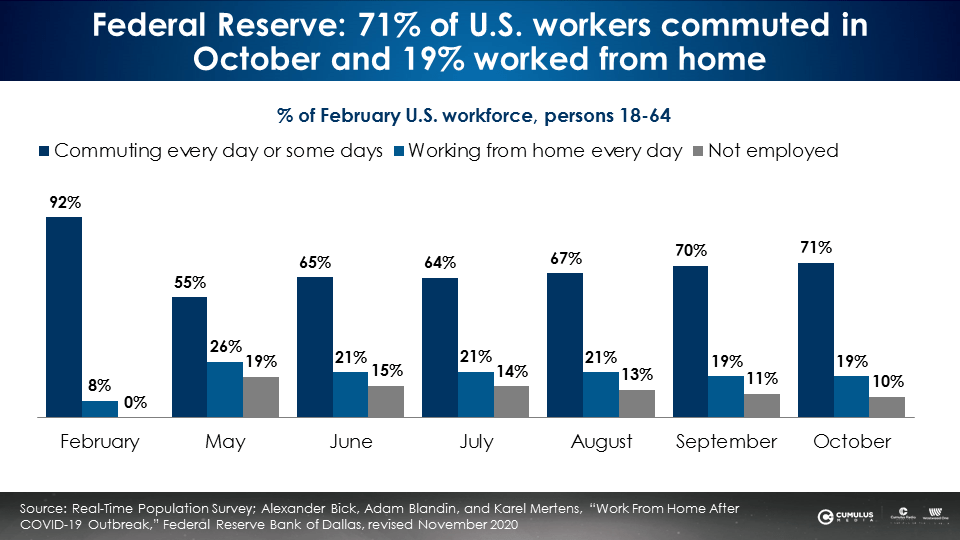
Similarly, AM/FM radio listening has seen a return to its pre-pandemic levels. According to the latest Nielsen Portable People Meter (PPM) market data for November 2020 and diary market data for August/September/October, AM/FM radio has rebounded.
Nielsen: November PPM reveals nearly complete reach recovery
Nielsen reveals that AM/FM radio’s November weekly reach is now 97% of March as the fall 2020 audience recovery continues.
Nielsen has identified four distinct phases of AM/FM radio’s audience recovery: Lockdown (April/May), reopening (June/ July), summer stability (August/September), and fall growth (October/November).
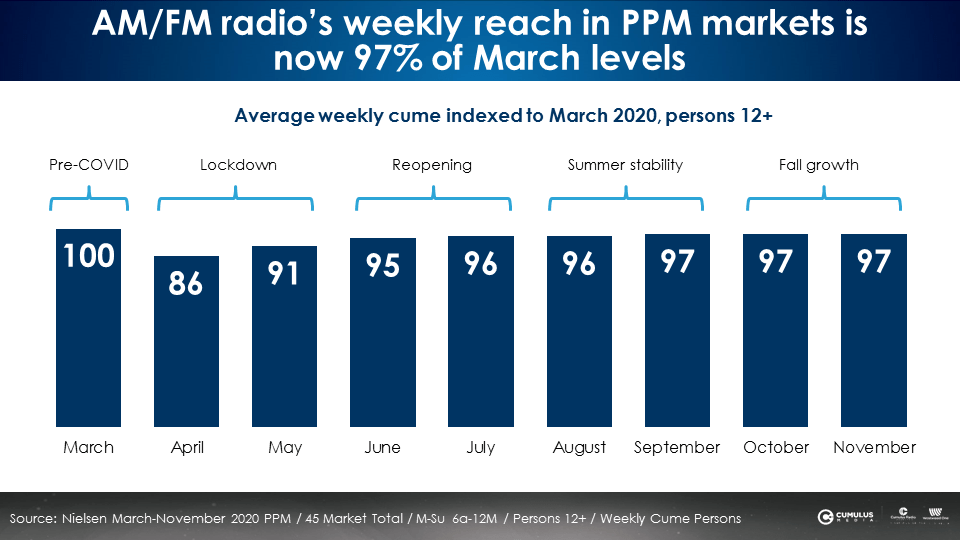
Nielsen: November PPM total day average quarter-hour persons is 94% of March
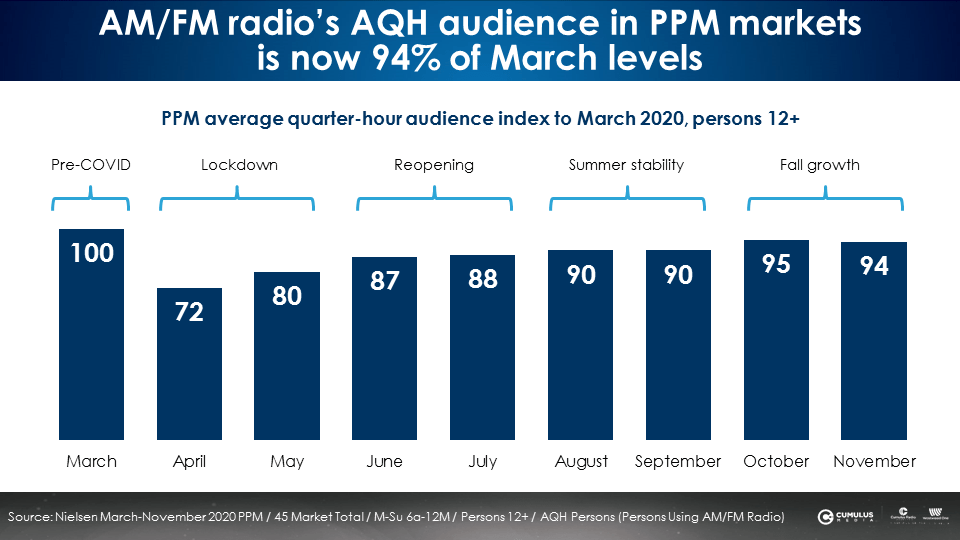
Nielsen: Morning drive audience recovery continues in PPM markets
The last two months have seen a significant surge in morning drive audiences. November’s Monday-Friday 6AM-10AM AQH is now 90% of March 2020. Middays are 96% of March, PM drive is 93%, nights are 88%, and weekends are 98%. Strong recovery performance in all dayparts.
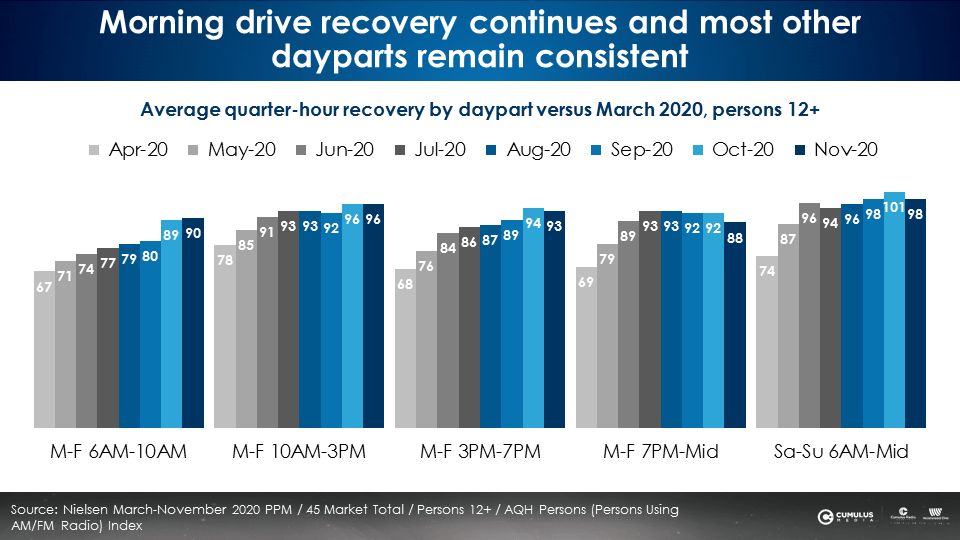
Nielsen: Continuous diary markets retain 100% of the March cume and average quarter-hour persons
The spring pandemic outbreak only impacted larger top 50 PPM markets. The medium-sized continuous diary markets saw barely any impact in spring AM/FM radio listening audiences. Since summer, mid-sized diary market audiences are virtually identical to pre-COVID listening levels. The latest August-September-October diary audiences show the exact same AQH and cume audiences as January-February-March.
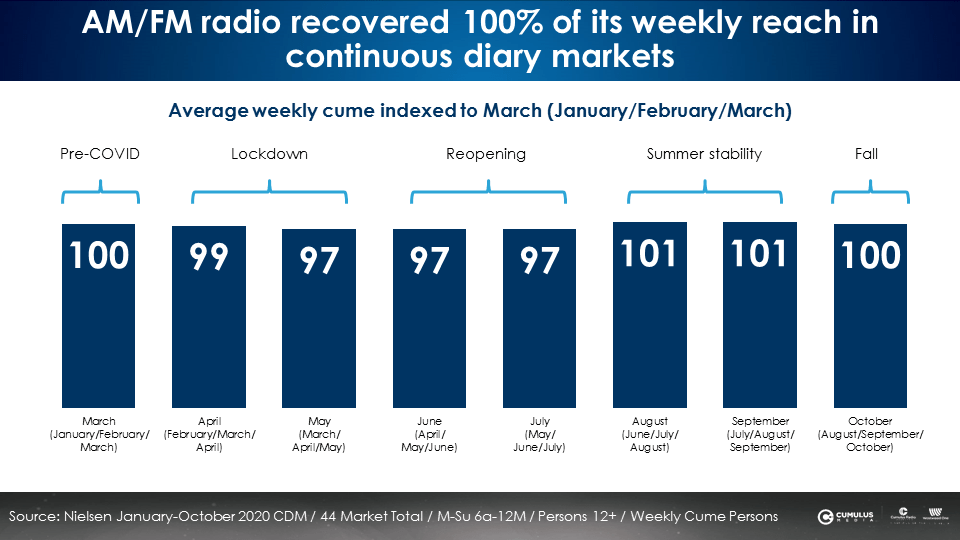

Key takeaways:
- Advertiser Perceptions: Marketers and agencies dramatically underestimate the number of Americans commuting to work and overestimate the number working from home
- Federal Reserve: Commuters outnumber work-from-home employees by nearly four to one; In October 2020, 71% of U.S. workers commuted to work and 19% worked from home
- Nielsen: In Portable People Meter markets the latest November 2020 data reveals AM/FM radio’s reach and average quarter-hour persons have recovered while morning drive continues to grow
- Nielsen: In continuous diary markets there has been no impact in listening levels versus pre-COVID according to the latest August/September/October 2020 release
Pierre Bouvard is Chief Insights Officer at CUMULUS MEDIA | Westwood One.
Contact the Insights team at CorpMarketing@westwoodone.com.